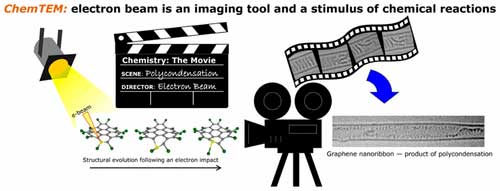| Posted: Mar 22, 2017 |
Caught on camera - chemical reactions 'filmed' at the single-molecule level
(Nanowerk News) Scientists have succeeded in ‘filming’ inter-molecular chemical reactions – using the electron beam of a transmission electron microscope (TEM) as a stop-frame imaging tool. They have also discovered that the electron beam can be simultaneously tuned to stimulate specific chemical reactions by using it as a source of energy as well as an imaging tool.
|
|
This research – which shows chemical reactions happening in real time at one hundred-millionth of a centimeter - has the potential to revolutionise the study and development of new materials. It could help answer some of the most fundamental and challenging questions of chemical science; such as how molecules react with each other at the atomistic level; what drives formation of one product instead of another; as well as aid the discovery of brand new chemical reactions.
|
 |
| Scientists have succeeded in 'filming' inter-molecular chemical reactions using the electron beam of a transmission electron microscope (TEM) as a stop-frame imaging tool.
|
|
The multi-national team of experts from the UK, Germany and Russia, was led by Andrei Khlobystov, a Professor of Nanomaterials and Director of the University of Nottingham’s Nanoscale and Microscale Research Centre. The study has been published in ACS Nano ("Stop-Frame Filming and Discovery of Reactions at the Single-Molecule Level by Transmission Electron Microscopy").
|
|
Professor Khlobystov said: “This is a significant scientific breakthrough. We have transformed the way we use TEM – from taking still images to a tool for filming and stimulating chemical reactions. It is the first time we have been able watch chemical reactions at this level and observe the fate of molecules as the chemical reactions take place - from the starting molecules all the way through to the product.”
|
|
The research was carried out by experts in synthetic and theoretical chemistry, materials and electron microscopy and builds on Professor Khlobystov’s concept of carbon nano test tubes (World’s tiniest test tubes, Guinness Book of World Records 2005), where the nanotube acts as a container for molecules. His pioneering work on carbon nano-containers and nano-reactors is already leading to new ways of directing molecular assembly and studying chemical reactions.
|
|
The UK research was carried out in collaboration with Elena Besley, a Professor of Theoretical Computation Chemistry and her team of researchers working in the Computational Nanoscience Group at the University of Nottingham.
|
|
Professor Besley said: “Delving into the tiniest chemical building blocks of matter, our study harnesses the ‘observer effect’ and establishes an entirely new methodology for studying chemical reactions. We demonstrate that the electron beam, simultaneously acting as an imaging probe and a source of energy to drive chemical transformations, offers a new tool for studying the chemical reactions of individual molecules with atomic resolution, which is vital for the discovery of new reaction mechanisms and more efficient future synthesis.”
|
Synthesis and preparation of new materials
|
|
There are still many problems in synthesis and preparation of materials and we need to understand the processes that create them, how exactly molecules react, how the chemical bonds break and form.
|
|
Professor Khlobystov said: “We named our method ChemTEM because it is the most direct way of studying chemical reactions: the electron beam delivers well-defined amounts of energy directly to the atoms within the molecule and thus triggers a chemical reaction, whilst continuously imaging the molecular transformations, frame-by-frame in direct space and real time. We can discover new chemical reactions and make bespoke chemical structures by playing with the conditions of the TEM – for instance the energy of the electron beam.
|
|
“We are now able to watch as individual molecules join together to form nanoribbons of graphene and polymers. We can then steer the reaction in the direction we want to form the material we want, and watch this happen in real time. For instance, we are already looking at the next generation of complex two-dimensional molecular materials for electronic applications beyond graphene.”
|
Embracing the ‘observer effect’
|
|
In microscopy much effort is invested in reducing the impact of light or electron beam – the so-called observer effect’ - on the sample to ensure that the images represent truly pristine structures, unaffected by the process of measurement.
|
|
The research team has employed the ‘observer effect’ to turn TEM into an imaging tool and a source of energy to drive chemical reactions.
|
|
The electron beam penetrates the atomically thin walls of carbon nanotubes and enables time-resolved imaging of the reactions at the single-atom level. Activated by the electron beam, the energy and dose rate which can be set precisely, chemical transformations of molecules take place.
|

